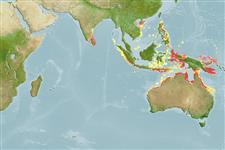Klassifizierung / Names
Namen | Synonyme | Catalog of Fishes(Gattung, Arten) | ITIS | CoL | WoRMS | Cloffa
Elasmobranchii (Haie und Rochen) (sharks and rays) >
Rhinopristiformes (Shovelnose rays) >
Pristidae (Sawfishes)
Etymology: Pristis: Greek, pristis = saw (Ref. 45335).
More on author: Garman.
Environment: milieu / climate zone / depth range / distribution range
Ökologie
seewasser; brackwasser demersal; tiefenbereich 1 - 20 m (Ref. 116378). Tropical; 20°N - 25°S, 46°E - 155°E (Ref. 114953)
Indo-West Pacific: tropical Australia, possibly more widely distributed. A nominal record from the Canary Islands may not be this species, but the sketchily known Pristis pristis from the eastern Atlantic is similar and needs comparison to determine if the two species are distinct (Ref. 009859). India (Bay of Bengal), Indonesia to eastern Australia, isolatted record from Réunion (Ref. 114953).
Size / Gewicht / Alter
Maturity: Lm ? range ? - ? cm
Max length : 318 cm TL Männchen/unbestimmt; (Ref. 116378); max. veröff. Alter: 34 Jahre (Ref. 116378)
Kurzbeschreibung
Morphologie | Morphometrie
Greenish brown, rarely yellowish; white ventrally; fins paler. Body shark-like, pectoral fins distinct; head flattened, with a blade-like snout bearing 18-22 pairs of lateral teeth; blade broad, not tapering distally. Nostrils broad with large nasal flaps. Rostral teeth slender, with a groove along posterior margins; teeth reaching basal quarter of blade. Skin with denticles.
Demersal in shallow coastal inshore habitats in mangrove swamps and embayments (Ref. 114953), intertidal species found in estuaries and on tidal mudflats (Ref. 9859). Ascends brackish areas of rivers (Ref. 9859). Ovoviviparous (Ref. 50449). Pupping thought to occur during the tropical wet season (November to March in Australia (Ref. 114953). Biology little known (Ref. 9859). Males mature at approximately 260 cm TL, females possibly slightly larger; born at 65 cm TL (Ref. 114953). Flesh may be good to eat (Ref. 6871).
Life cycle and mating behavior
Geschlechtsreife | Fortpflanzung | Ablaichen | Eier | Fecundity | Larven
Ovoviviparous, embryos feed solely on yolk (Ref. 50449).
Compagno, L.J.V. and P.R. Last, 1999. Pristidae. Sawfishes. p. 1410-1417. In K.E. Carpenter and V. Niem (eds.) FAO identification guide for fishery purposes. The Living Marine Resources of the Western Central Pacific. FAO, Rome. (Ref. 9859)
IUCN Rote Liste Status (Ref. 130435)
Warning: mysqli::__construct(): (HY000/1040): Too many connections in /var/www/html/includes/func_getlabel.php on line 46
Can't connect to MySQL database (fbapp). Errorcode: Too many connections
